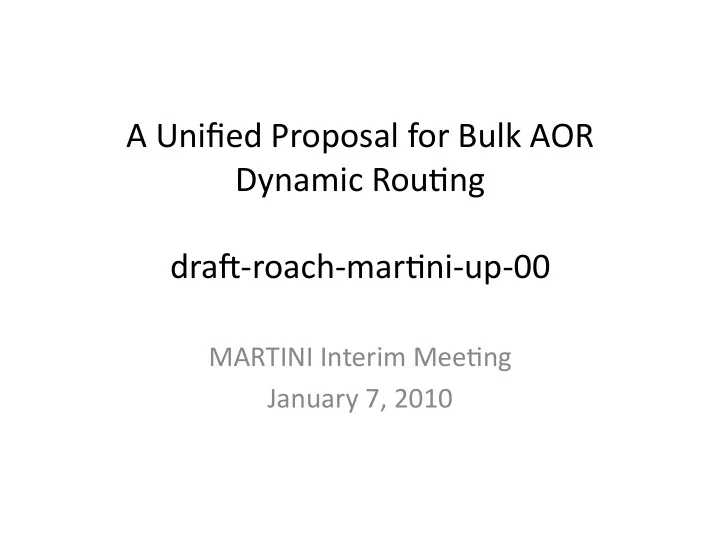

A Unified Proposal for Bulk AOR Dynamic Rou:ng dra<‐roach‐mar:ni‐up‐00 MARTINI Interim Mee:ng January 7, 2010
Problems with Proposed/Deployed Models • REGISTER seman:cs inherently deal with a single user. • Extending REGISTER to work with mul:ple users is a change to the exis:ng authoriza:on model for a core SIP request method. This may break assump:ons of deployed servers.
Problems, con:nued • By reversing model of who indicates the AORs being registered (i.e., delega:ng determina:on of registered AORs to the registrar using implicit registra:on), ar:ficial mismatches between SSP behavior and PBX expecta:ons can arise. – No good solu:on: by the :me the PBX knows something is wrong, the incorrect network state is already created. – When the PBX detects the error, there is no protocol recovery path. – If we return to the model in which the client explicitly indicates the AORs under considera:on, and the server indicates whether the requested AORs are in policy, then this ar:ficial problem dissolves.
Many Documented “Problems” are Issues with Solu:on • Many of the documented “problems” are not inherent to the issue of bulk registra:ons, and arise only from stretching REGISTER in direc:ons it was never intended. These problems simply dissolve when addressed using other mechanisms: – The need for explicit indicators – PAU mismatch issues – Register response sizes – Target informa:on loss – “Loose rou:ng” issues
“Backwards Compa:bility” is a Fallacy • Objec:ons to using approaches other than a “tweaked REGISTER” generally reduce to “but we currently have REGISTER deployed.” • Currently deployed solu:ons suffer from myriad problems; cf. mixing‐problems document. • Therefore, protocol changes are required. • If protocol changes are required, then all currently deployed solu:ons require upda:ng.
Overview of Proposal • Informa:on in SIP Loca:on Server db is available through two mechanisms: – REGISTER can both set and get informa:on for a single user – SUBSCRIBE/NOTIFY with ‘reg’ event package can get informa:on for mul:ple users • Natural extension of the foregoing: PUBLISH with ‘reg’ event package can set informa:on for mul:ple users
Behavior • Publisher (e.g., SIP PBX) publishes and maintains routes using ‘reg’ event PUBLISH requests. To conserve space, we define a new body type for ‘reg’ event that can aggregate several AORs into a single record. • Dynamic Rou:ng Server updates Loca:on Server db with informa:on from PUBLISH requests.
Example: Rou:ng E.164 Range PUBLISH sip:company@rou:ng‐server.example.com SIP/2.0 Via: SIP/2.0/UDP server19.example.com;branch=z9hG4bKnasaii From: sip:pbx.example.com;tag=xyzygg To: sip:company@rou:ng‐server.example.com Call‐ID: 9987@app.example.com CSeq: 1288 PUBLISH Max‐Forwards: 70 Expires: 3600 Event: reg Content‐Type: applica:on/reginfo‐bulk Content‐Length: ... 1 full /sip:+1214329(0...)@example.com/sip:\1@pbx.example.net/ 14 registered
Example: Rou:ng Domain PUBLISH sip:company@rou:ng‐server.example.com SIP/2.0 Via: SIP/2.0/UDP server19.example.com;branch=z9hG4bKnasaii From: sip:pbx.example.com;tag=xyzygg To: sip:company@rou:ng‐server.example.com Call‐ID: 9987@app.example.com CSeq: 1288 PUBLISH Max‐Forwards: 70 Expires: 3600 Event: reg Content‐Type: applica:on/reginfo‐bulk Content‐Length: ... 1 full /sip:(.*)@example.net/sip:\1@192.0.2.5/ 14 registered
Example: Rou:ng Mul:ple Ranges PUBLISH sip:company@rou:ng‐server.example.com SIP/2.0 Via: SIP/2.0/UDP server19.example.com;branch=z9hG4bKnasaii From: sip:pbx.example.com;tag=xyzygg To: sip:company@rou:ng‐server.example.com Call‐ID: 9987@app.example.com CSeq: 1288 PUBLISH Max‐Forwards: 70 Expires: 3600 Event: reg Content‐Type: applica:on/reginfo‐bulk Content‐Length: ... 1 full /sip:+1214329(0...)@example.com/sip:\1@pbx.example.net/ 14 registered /sip:+1919555([123456789]...)@example.com/sip:\1@pbx.example.net/ 14 registered
Advantages • By mimicking REGISTER on an AOR‐by‐AOR basis, many of the problems that arise from implicit registra:on with mul:ple users are completely sidestepped. – “Loose rou:ng” and “target URI” problems disappear – request processing is iden:cal to singly‐registered AORs. – Ambigui:es that cause authoriza:on policy and “P‐Asserted‐Iden:ty” mismatches are far clearer with this model.
Advantages, cont. • Because REGISTER is not overloaded to mean two different things, no explicit indicator is required. • Because the UAC specifies the AORs to be routed, no opportunity for (e.g. P‐Associated‐URI) mismatches arise. • Also because the UAC specifies the AORs, response size is not an issue. • Compact representa:on of AORs to be routed helps manage total message sizes.
Recommend
More recommend